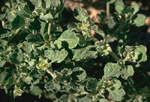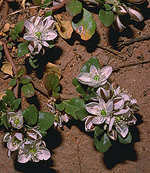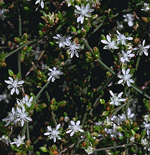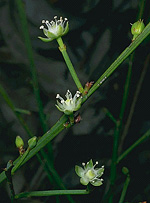 |
This small family is mostly southern African, although a few genera are pantropical. In Australia, various species occur in dry parts of mainland Australia mostly south of the Tropic of Capricorn, often in drying sand or clay in seasonal watercourses or around the edges of drying claypans.
Characteristic features of the family Molluginaceae in Australia include: - annual or perennial herbs, rarely sub-shrubby
- leaves opposite, alternate or whorled, simple, narrow and linear to broadly ovate.
- flowers small, axillary, bisexual, regular, with a perianth of 4 or 5 usually free, whitish or greenish segments
- stamens usually 5 or 10, rarely less, sometimes numerous
- ovary superior with 2-5 free styles, developing into a capsule
Description
Evergreen subshrubs, or annual or perennial terrestrial herbs. Perennating by taproots or crowns. Stem internodes terete, oval or slightly flattened or strongly flattened. Internal secretions not obvious. Plants glabrous, or with simple, non-glandular, uniseriate hairs. Leaves well developed or much reduced (i.e. to scales, etc), alternate and spiral, opposite or in whorls of 4, cauline or both basal and cauline if herbs, petiolate, subsessile or sessile. Stipules absent or falling off early. Lamina simple, symmetric, filiform, acicular, subulate, linear, lanceolate, ovate, elliptic, oblanceolate or obovate; base rounded, cuneate or attenuate; margins entire, ±flat; one-veined, or not obvious, with the midrib conspicuous or inconspicuous, and the tertiary venation not reticulate; surfaces not punctate; herbaceous or somewhat fleshy. Plants with all the flowers bisexual. Inflorescences terminal or axillary, consisting of dichasial or monochasial cymes. Bracts present. Pollination by insects. Flowers odourless or fragrant; stalked. Floral disc present or absent; nectaries absent or present on the disc, the carpels or the stamens. Free hypanthium present or absent. Perianth regular, of 2 dissimilar whorls, or 1 whorl only, imbricate in bud. Calyx segments free or fused, with 5 sepals or lobes, herbaceous. Corolla segments free or fused, with 0 or 5 petals or lobes, alternating or with no clear relationship to the sepals or calyx lobes, white, cream or pink, without contrasting markings, membranous; claws present or absent; lobes ±entire. Fertile stamens 3–20, alternating with or not clearly correlated with the sepals or calyx lobes, free of the corolla, free of the ovary and style, fused by their filaments into an open or closed tube, all ±equal. Staminodes present or absent. Anthers dorsifixed, versatile, opening outwards, sideways or inwards by longitudinal slits, 2-celled. Ovary superior and sessile, or part-inferior or inferior. Carpels 3–5, fused; ovary with 3–5 locules. Style terminal, branching from the base, terminal. Ovules 1–numerous per locule, stalked; placentation axile. Fruit a dry dehiscent septicidal or a loculicidal capsule; the perianth on the maturing fruit deciduous, or dry and persistent. Disseminule micro-surface verrucose, tuberculate or reticulate, grey or black, glossy or dull. Seeds 3–numerous per fruit. Aril present or absent. Cotyledons 2. Embryo curved.
(Note: this description has been generated from the coded data compiled for the key. Any errors in the key data will be reflected in the descriptions.)
A treatment of the family Molluginaceae has not yet been published in the Flora of Australia. It will appear in Volume 5.
Australian genera of Molluginaceae (as recognised for the Flora of Australia)
Glinus
Macarthuria
Mollugo

|
  |

Glinus lotoides (flowers)
Photo: M.Fagg © M.Fagg

Glinus orygioides (flowers)
Photo: D.Albrecht © Parks & Wildlife Commission of NT

Macarthuria australis (flowers)
Photo: M.Fagg © M.Fagg

Macarthuria ephedroides (flowers)
Photo: M.Fagg © M.Fagg

|
 |
|